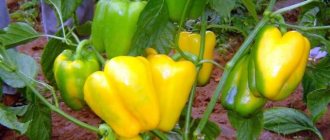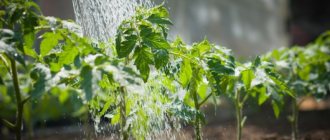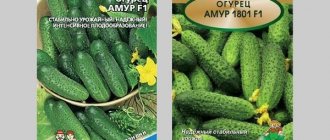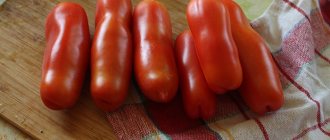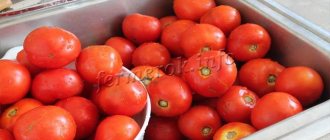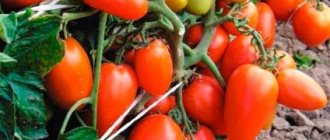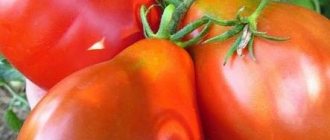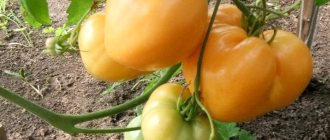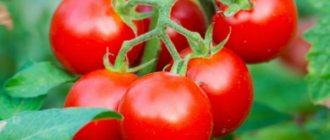Description and characteristics of the sweet pepper variety
The Ramiro variety was obtained in Italy. It is actively cultivated in European countries and Latin America. There are several varieties of the variety that differ in the color of the fruit.
The bushes are strong and tall with a developed root system. The culture reaches a height of up to 1 m. The plant is decorated with elongated, ovate, wrinkled foliage of dark green color. When flowering, the crop forms many white buds.
The Ramiro variety is valued for its fruits, which can be red, yellow, less often green or orange. Their shape is elongated. The average weight of one vegetable is from 90 to 160 g. The fruit grows up to 25 cm in length and up to 4 cm in diameter. Walls 6 mm thick. The skin is thin, with small partitions inside. There are few seeds compared to other varieties of the crop. The taste is sweet, not at all bitter, like bell pepper.
The fruits reach biological ripeness 130 days after the formation of seedlings.
Information! In Russia, inexperienced gardeners confuse the name of this crop: they call this sweet red pepper Romano or Romero.
Vegetable fruits
Origin story
The history of the selection of a variety or variety type is somewhat confusing, but the De Ruiter company is considered the originator. Currently, the Dutch company is part of the famous German concern Bayer AG.
It is believed that Ramiro includes a whole line of varieties of Dolche Italiano sweet peppers:
- Ramiro Yellow;
- Ramiro Orange;
- Ramiro Red.
The differences are in the color of the pods, other characteristics are the same. The Ramiro variety has also been developed, in which the fruits remain green in a state of full biological ripeness.
On a note! Manufacturers offer Ramiro seeds for sale from the island. These kits contain seed material of red, yellow and orange peppers.
Opinions differ regarding the type of sweet pepper - variety or hybrid. Gardeners collect the seeds, obtaining fruits that are similar in appearance to the parent forms, as well as others. Characteristic signs of Ramiro:
- narrow pod;
- bend in the middle;
- creases in the stalk area;
- thin pericarp (3-4 mm).
When using your own seeds, you may lose varietal characteristics and obtain fruits with smooth and thick-walled skin.
Advantages and disadvantages of the variety
Ramiro has a lot of advantages that distinguish it from its competitors:
- high productivity - up to 2 kg of vegetables can be obtained from one plant;
- excellent taste and attractive appearance of the fruit;
- the possibility of growing in greenhouses, greenhouses, and also in open soil;
- ease of care;
- resistance to diseases and pests;
- source of vitamin C, B, H, PP, beta-carotene, fiber.
Disadvantages include the culture's susceptibility to stolbur and the need for tying up bushes.
Advantages of the variety
How to grow?
We have introduced you to a description of the Ramiro pepper variety - it’s time to talk about the basic rules for growing and caring! This is a fairly unpretentious plant that can be planted in greenhouses and open ground, provided there is sufficient sun.
Planting seeds and growing seedlings is done as follows:
- Before sowing, place them in a manganese solution for several hours;
- After complete swelling, place the seeds on damp cotton wool and leave for a couple of days;
- The growing container should be small - about 12-15 cm in diameter;
- Sow seeds to a depth of 1-1.5 centimeters;
- Cover the emerging shoots with a glass cap and do not forget to water;
- The optimal temperature is 21 degrees during the day and 15 degrees at night;
- The cap should be removed at least once a week to ventilate the sprouts.
Done, now it’s time to transplant the seedlings into open ground! A little advice - be sure to alternate sprouts with cucumbers, cabbage or zucchini, do not plant them in a continuous strip.
- The soil is light - it must first be disinfected with copper sulfate;
- It is worth planting seedlings in May or June, 4 bushes per meter, depth - 1.5 cm maximum.
The Ramiro bush is formed in several stages:
- First, the top flower is removed;
- After the bush has acquired at least ten leaves, the stems are gradually removed - leaving 3-2 shoots;
- The lower leaves are removed as they mature.
Rules of care
Let's briefly go over the rules of care - they allow you to achieve high yields of bushes:
- Water once a week with warm, settled water;
- Use organic matter for feeding - nettle, dandelion and ash with manure are great.
An interesting way to grow peppers in buckets:
That's it - now you can grow delicious sweet ramiro peppers yourself! Try to create your own vegetable garden, because the plant is quite easy to care for, even a novice gardener can handle it!
We also recommend: What is a burrito?
Features of cultivation
Experienced gardeners advise cultivating Ramiro sweet peppers only using seedlings.
Seed selection and preparation
The seed material must be free of obvious flaws, large in size and not hollow. After checking, the seeds should be placed in a potassium permanganate solution for 20 minutes for disinfection. Then place them on a wet gauze cloth and leave for 2-3 days.
Seed preparation
Sowing, watering and caring for seedlings
It is recommended to plan sowing work for February. To do this, you need to know what kind of soil is suitable for planting. You can make your own soil mixture by taking humus, sand, and garden soil in a ratio of (2:1:1). As a fertilizer, add 1 tbsp to the soil. l. wood ash.
Diseases and pests
- With abundant watering, the plant may suffer from fungal diseases, which can be eliminated by using the drug Barrier. The same remedy can also act as a prophylactic composition, since it contains components that have a positive effect on the immunity of pepper.
- When late blight or anthracnose develops, copper-containing preparations are used. Suitable options include a solution of Bordeaux mixture or Oksikhom.
- Regarding parasites, there is a possibility of infection by spider mites, aphids or slugs. To destroy them, use a Barrier or Regent. The drugs also act as prophylactic agents.
Ramiro pepper has excellent taste and high resistance to diseases, due to which it is widely used by many gardeners.
Read our other materials about the beneficial properties and features of growing sweet orange and thick-walled, hot, black, decorative peppers, as well as the varieties Ogonyok, Aladdin, Partner, Polet and Kakadu.
Features of outdoor care
To obtain the maximum yield of Ramiro vitamin fruits, it is important to follow certain care rules, taking into account all the features and characteristics of the variety.
Watering
The frequency of watering depends on the stage of crop development. During the period of intensive growth of bushes and filling of the crop, it should be moistened once a week. At the moment of formation of the ovaries, increase watering to 2-3 times every 7 days. Up to 6 liters of water will be required per 1 m² of area.
Advice! After moistening, it is important to loosen the soil, otherwise the plant’s roots will not receive enough oxygen.
Watering the plant
Fertilizer
During the growth of pepper, to increase the quantity and quality of the harvest, it is important to feed the plants with organic and mineral fertilizers. They are usually applied once every two weeks, alternating between different types.
Reviews from those who planted
Olga
I selected seeds from store-bought peppers, selecting only straight, marketable ones. At the end of winter, after checking for germination, I planted it as seedlings. The pepper was a great success. In the summer, he pleased me with the same fruits that I bought in the store. This suggests that this is a variety and not a hybrid. The taste of the fruit was wonderful - sweet, aromatic and juicy.
Peter
After reading various reviews, I found this pepper in the store and collected the seeds. At first I thought it was a type of chili. But I am very pleased with the grown fruits - they are sweet and fleshy. Its salads are simply wonderful. And my wife makes wonderful winter lecho from it.
Galina
This pepper is much tastier than those sold in our stores in winter. But it still doesn’t keep well in my home environment. And yet, until the New Year, I can please myself and my friends with the fruits of this delicious bell pepper.
Harvest and storage
The harvest should be harvested 85-94 days after the fruit appears. Pick the first peppers at technical ripeness. This will allow the plant to gain strength and form the next batch of ovaries.
The fruits of the next wave can be left to ripen on the bushes. This harvest will increase the overall yield.
Store the harvest in a cool room or refrigerator.
Harvest
Experience in growing Ramiro and personal impressions
At seedling age, seedlings of “Ramiro” pepper differed from their counterparts from the very beginning in their growth rate and larger size; they also bloomed earlier than others. We were able to pick the first pepper at technical ripeness at the end of June.
To be honest, at that time the taste of the Ramiro pepper did not impress me at all; it was dryish, thin-walled, and had not yet acquired the declared sweetness (perhaps this was also due to the fact that the summer that year was cool).
I left Ramiro for a while and switched to using other varieties of pepper. The second attempt at culinary use of this pepper also turned out to be a failure. This time we decided to bake it on the grill, but my husband didn’t pay attention, and due to the thin walls of the pepper, the pod simply charred almost before our eyes.
Perhaps, after this incident, I would forever keep with myself the negative impressions of the variety, along with my bewilderment as to why it is so popular. But, as usual, chance helped. At the end of summer, when we returned home from the dacha, I decided to bake the peppers with other vegetables in the oven, and among the baked peppers there was also “Ramiro”. That’s when I discovered its divine taste!
We simply didn’t want to eat other slices of pepper, because compared to “Ramiro” they seemed tasteless, although baked pepper is very popular in our family. It was after careful baking that “Ramiro” revealed the maximum sweetness of its delicate pulp, while it did not have the bright aftertaste characteristic of bell peppers.
I imagine that people with an aversion to the typical smell of sweet peppers could happily enjoy a dish with the addition of Ramiro without even realizing that pepper was present. Personally, the baked Ramiro slices reminded me of exquisite tender meat or fish, but not pepper at all.
Another feature of “Ramiro” - a very thin skin during baking also turned out to be useful, and if the skin of other varieties of pepper felt rough, and there was a desire to remove it, then “Ramiro” seemed to have no skin at all, which added even more tenderness to the slices.
At the same time, the pulp had a uniform, appetizing consistency, and did not fall apart, as in some juicier varieties. After this successful experiment, I decided to plant Ramiro pepper in double quantity.
Although Ramiro pepper is considered a universal variety, I would advise using it specifically for baking, but for fresh salads there are juicier and thicker-walled varieties.
However, I definitely recommend this variety to those who like to bake vegetables on the grill or in the oven; in this case, “Ramiro” is difficult to find equal to, and you will certainly like it.
gardening tipsfertilizersharvestplantssoilcottagevegetable gardenseedlingsvegetables
Application and beneficial properties
Use of vegetables
Ramiro red pepper is used both fresh and for home preparations for the winter. This is one of the most popular vegetables for barbecuing. At the same time, cooking over fire enhances the characteristic sweet taste. Also, the durable wall structure allows you to grill vegetables. This juicy fruit is suitable as a quick snack and is used in sandwiches.
Eating healthy pepper will increase immunity, improve intestinal motility, normalize the functioning of the gastrointestinal tract, and remove harmful substances from the body.
By following all agrotechnical cultivation techniques and following care recommendations, you can get a generous harvest of healthy peppers of good quality.
The benefits and harms of pepper
The description of ramiro pepper needs to be supplemented by listing the beneficial and negative properties of the plant. Among the positive qualities are:
- Strengthening immunity;
- Improving intestinal motility;
- Normalization of the gastrointestinal tract;
- Removal of waste and toxins.
Low calorie content and pleasant taste are characteristics that are valued by lovers of diets and healthy eating. There are a couple of negative points that are worth mentioning:
- May provoke the development of allergies;
- Causes heaviness in a sensitive stomach.
Also recommended: Szechuan pepper
Once you know whether ramiro peppers are sweet or hot, you can easily use them in cooking - let's quickly go over the main uses!
Landing
Seeds are not always available in regular agricultural stores, so farmers order seed material or share it among themselves.
For cultivation in greenhouses, sowing begins in January. If you plan to cultivate the variety in open areas, the seeds are planted in February - March.
For seedlings, loose nutritious soil is prepared (you can buy ready-made soil in the store). Optimal composition:
- 2 parts of turf (garden or park);
- 1 part peat;
- 2 parts rotted humus;
- 0.5 parts sand;
- as additives - perlite, vermiculite, vermicompost.
Seedlings are grown in planting containers or boxes, the height of their walls should be 10-12 cm. A 1-2 cm layer of drainage - expanded clay, pebbles - is laid on the bottom. The soil layer is 7-8 cm. Seeds are sown in furrows 1 cm deep in moist soil. Sprinkle well with a spray bottle and cover with a thin layer, compacting.
The step between holes is 4-5 cm. Until germination, the plantings are kept warm under a film.
After 8-11 days, shoots begin to appear. The seedlings are moved to a bright place, and additional LED lighting is connected. Maintain the mode within 21-26 degrees. Humidity is constantly monitored, avoiding overmoistening (there is a risk of blackleg and rot) or drying out.
In 10-14 days, the bushes begin to prepare for replanting using the hardening method. The seedlings are placed on a loggia or veranda with a temperature of 14-18 degrees. The time is increased gradually - from 15-20 minutes to 8-10 hours.
Planting sequence
Digs of 15 cm are dug in the ground. Seedlings are planted at a distance of 0.4 m from each other. The distance between the rows is 0.5 m. It is recommended to place this plant in a checkerboard pattern, because this way it is easier to care for it.
Seedlings are planted in dug holes along with a lump of earth. The roots are covered with earth and lightly compacted.
Take warm water and pour it over the pepper. Now you need to mulch the ground with compost or peat.
How often to water peppers in open ground - step-by-step instructions and description of proper watering of bell peppers (100 photos)
Pepper leaves with holes - how to treat them? Review of diseases, pests and methods of plant protection (85 photos)
Pepper varieties - 125 photos and descriptions of the best varieties. Rules for planting and growing in greenhouses and open ground
After the plant is planted in open ground, it should not be watered or fertilized for about 7-10 days, as it needs to take root.
